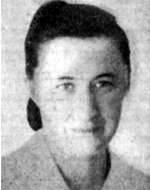Chaya, the daughter of Gitel and Benjamin, was born on February 9, 2222 in Poland, in the city of Oswiecim in the southwest of the country, near Krakow. Her parents were engaged in commerce. Chaya was brought up in the way of Hasidic girls in that environment: education for general education in a Polish government school, and for traditional life at home. With the beginning of World War II and the German occupation (September 1939), Oswiecim was annexed to the Reich. The young Jews were taken to labor camps in the Sudetenland, which were administratively subordinate to concentration camps in Germany. In July 1940 the construction of the large concentration camp near Oswiecim, which later became the largest cemetery in the history of mankind – Auschwitz-Birkenau. The first forced laborers forced to work in the construction of the camp were 300 Jews from Oswiecim and its environs. More than 1.5 million Jews were murdered in this camp, among them nearly 8,000 Jews from Oswiecim. Chaya was among the young men sent to a labor camp at the beginning of the war. She spent three years there, and like the other women, she was employed in armaments and textile factories. During this period she was separated from her family – her parents and three brothers were exterminated in Auschwitz. Later she moved between a number of labor camps and managed to hold out until the end of the war. After the liberation Chaya joined the “Ichud” kibbutz in Ostrowitz, Poland. With the kibbutz she moved to Germany and entered the refugee camp at Degendorf, in the American Zone. She was a partner in the founding of the “Nogev” agricultural training commune of the Nocham (United Pioneering Youth) movement in the Minkofen farm, and in the winter of 1947 she immigrated to Israel on the Bracha Fuld, a small coastal ship purchased by the Mossad Le’Aliya Bet “Bracha Fuld” sailed from the port of Mola di Bari on October 9, 1946, carrying 626 Ma’apilim – survivors of concentration camps and members of kibbutz youth movements, whose sailing was characterized by many mishaps and severe weather conditions. , Was towed to the port of Haifa, and after a severe struggle its passengers were deported to Cyprus, and the deportation of the immigrants caused violent incidents in which they were involved And in the wake of these events, Natan Alterman published the song “Bracha Fuld” in his weekly column in Davar, and when she arrived again on the shores of the country in June 1947, she was forced to spend another period in the camp At the time, when she was released from the Atlit camp, Chaya arrived at Kfar Etzion, the first of the Gush Etzion settlements in the Lev of Mount Hebron. There was a great deal of suffering and wandering across the European camps. Learned a lot from the past and asked to build her life here on the Shiloah springs. She modestly and quietly did her work and for a long time did not feel it in social life. Did not stand out in speech, but was noted with cleverness and knowledge of life. Gradually she was hired and found a place in society. “She accepted every task and task, and was sufficiently well-equipped to accept everything easily, hoping to take a few days off to explore the countryside and explore its landscapes, but not enough – In November 1947, the establishment of a Jewish state, a decision that left Gush Etzion outside the borders of the state, began with the Arab siege of Gush Katif and, like all the adult members, Chaya was recruited for his defense. “) Participated in training, observation, guarding, and providing food to defenders in positions.For most of the months of the campaign, Gush Etzion was under siege, The connection with the Gush was preserved thanks to a number of vehicles that broke through from Jerusalem,And made several small planes using an improvised landing site. Sometimes supplies and weapons were dropped into the block. The Haganah reinforced the bloc with the fighters of the Field Corps and fighters from the Harel Brigade of the Palmach. All these helped the Gush members survive through May 1948. On May 12, 1948, the Etzion Bloc was attacked by Jordanian Legionnaires who were reinforced by armored vehicles and artillery, joined by a large Arab force from the nearby villages. The Arab force succeeded in conquering several outposts in the vicinity of Kfar Etzion. The next day, the 4th of Iyar 5708 (13.5.1948), the largest attack was carried out, during which Kfar Etzion was conquered, and when the Legion burst into the village, she lived with her friends in a shelter under the German monastery. The next day, on May 14, 1948, the day of the declaration of the State of Israel, the defenders of the Haganah surrendered The three settlements of Gush Etzion: Revadim, Masuot Yitzhak and Ein Zurim. On this day the Gush ceased to exist, and the remnants of its defenders were taken prisoner by the Jordanians. Haya was twenty-six years old in the fall. The bodies of the fallen remained there for about a year or more. Their remains were collected in a special operation by the military rabbinate in 1949. They were brought to eternal rest in a large mass grave on Mount Herzl in Jerusalem, at a state ceremony held on the 17th of Cheshvan 5710 (17.11.1949). This hero is a “last scion”. The survivors of the Holocaust are survivors of the Holocaust who survived the last remnant of their nuclear family (parents, brothers, sisters, sons and daughters) who experienced the Holocaust in the ghettos and / or concentration camps and / or in hiding and hiding in territories occupied by the Nazis and / Or in combat alongside members of the underground movements or partisans in the Nazi-occupied territories who immigrated to Israel during or after World War II, wore uniforms and fell in the Israeli army.
